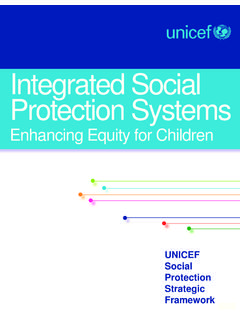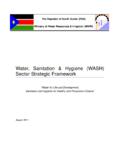Transcription of http://www.un.org/esa/socdev/social/papers/koivusalo.pdf
1 Social funds, social policies and social development Paper presented to the Expert Group meeting on Social Funds and Poverty Reduction Meri Koivusalo, MD,Phd, MSc Senior Researcher Globalism and Social Policy Programme STAKES draft- please do no quote Social policies of some kind are implemented in all countries. It is their relevance to further social and human development, which tends to vary. However, social policies are often not conceptualised as social policies in the development context, but rather dealt with in a broader concept of social development or in the context of poverty reduction strategies. The aim of this short paper is to ask what kind of social policies social funds represent and what is their relation to social development. In the area of social policies it is futher concerned about social services, such as education and health services.
2 I will discuss social funds in the context of three elements of social policies. Firstly, in terms of what kind of social policy approaches and models these represent, secondly how social funds relate to administrative matters or in other terms how effective are they as means of social policies and thirdly what kind of issues how relevant are social funds to the achievement of social developent and Millenium Goals. Social policies While models of social policies are often insufficient, they do provide a basis for analysing the ways in which countries engage in efforts of social development. This paper draws from the ways in which social policies have been presented by Titmus (1974) in terms of the basic distinction between the institutional redistributive model of social policy and the residual welfare model of social policy.
3 The basic division between these models can be seen in the basic assumptions. In the residual model the basic assumption is that markets and families are the natural channels to fulfil citizens welfare needs and social policy measures should take place only when these do not function and as temporary replacement. In the redistributional intitutional model social policy is an integrated part of public policies which providers for services and benefits for citizens outside markets on the basis of needs. Korpi (1983) has further explored the potential differences between marginal and institutional models of social policy in terms of share of social expenditure, participating population, employment oriented measures, preventive measures, predominant type of intervention, main type of financing, progressivity of financing, role of nongovernmental organisations and role of means testing and social control.
4 In many ways debates around poverty reduction and social funds still deal with many of these issues and divisions. These two models can be seen as 'ideal types', but they do provide a ground for a basic analysis of social policies which could be useful also in the context of development policies and perhaps more useful in a development context than later comparative welfare state models contextualised mostly in the developed countries (Esping-Andersen 1990). Ginsburg has also brought further dimensions of class, race and gender divisions to the analysis of comparative social policy (Ginsburg 1992). In the 'real world', the United States model and to some extent the United Kingdom model of social policies can be seen as ideologically closer residual model, whereas the old nordic models of welfare states can be seen to have followed the institutional redistributive models of social policies.
5 While most welfare states are based on mixed models, there are clear differences in emphasis and practice which to some extent follow initial divisions by Titmus and Korpi and can be helpful in providing possible alternatives and choices in social policies or at least in understanding the scope of social policies In the context of development policies the model used tends to be implicitly a residual welfare model of social policy. In many countries poverty reduction also needs to focus on growth and could not be based on redistribution. However, social inequalities and relative inequalities are becoming more of an issue due to debates and concerns over impacts of globalisation, which have taken place especially around the WIDER Institute conferences and working papers (see Cornia 2001, Milanovic 2003).
6 The linkage between economic and social policies have also been reflected in the work of UN/DESA and the Social Commission. The interface and linkage between economic policies and social policies has also been raised recently by Mkandawire (2001) and will be further dealt with in the context of the UNRISD research programmes. It is clear that there is also a continuous debate between requirements of macroeconomic frameworks of economic policies, poverty reduction and resource allocation to provision of basic services. Attention has been drawn to the meagre resources available to basic social services (Mehrothra and Delamonica 2002). In terms of the initial purpose of social funds there is no doubt that they represent a very residual model of social policies and that their original role was meant merely to support implementation of economic reforms.
7 The experiences of the early social funds and safety nets in poverty reduction have been very limited (Cornia 2001, Vivian 1995). However, in spite of the limited benefits the schemes have continued, most probably due to other reasons. The temporary structures have now become more permanent and widely utilised to disburse social sector funds. Furthermore, these seem to be seen also as a model for reform of the public sector and local governance for future. Social funds as means of social policies This leads us to the second area of analysis, the assessment of social funds as means for social policies. The initial issues between the residual and institutional models are reflected also in here. Discussion and debate along the lines of the initial divisions can be seen, for example, in the organisation and financing of services and the emphasis on selectivity and targeting in service provision.
8 The provision of public basic services has been generally seen as a good means of social policies. The UNRISD review on public policies concluded that investments and committment in basic services in education and health have been important in the so called success stories in social development (Ghai et al 1999). Amartya Sen has also promoted the so called 'support-led' approach of investing on basic social services on the ground that they are labour intensive and thus relatively inexpensive in poor - and low-wage - economies. A poor economy may have less money to spend on health care and education, but it also needs less money to spend to provide the same services. (Sen 1999). The relationship between social services and social funds is, however, at best very mixed. Firstly, social funds have been used to finance services infrastructure and building and in general they have been seen as temporary and more concerned about capital funding.
9 This has implied an implicit bias towards building things in comparison to longer term maintenance and recurrent costs. While the employment and poverty reduction-related aspects of social funds have been challenged, it is also necessary to see the role of social funds in the changing context of service provision. In aid policies the relation between general budget support to social sector and support to social funds is an issue and requires attention especially if these are not seen as competing areas. There is a problem, if financing and most capable personnel working in the provision of social services is shifting to social funds and fund governed projects. The concern over negative institutional effects on public planning processes and budget accountability have also been raised by the OED department review of social funds (World Bank 2002, Carvalho et al 2002).
10 It seems that even the World Bank seems to have mixed feelings about their role as means of new social policies and rather sees them in a more limited role and as complementary to provision of basic social services (van Domelen 2002). However, they have been seen also as an example for the modernisation and public sector reform (World Bank 1998). If social funds are to be seen as the example for public sector reform and benefits of community-based and demand-based approaches, then a proper evaluation needs to take place to what extent social funds themselves represent these (see Tendler 2000, Tendler and Serrano 1999) and to what extent these represent a more efficient way in providing public services. Social fund projects gather own financing which is reflected in user charges and fees.


















